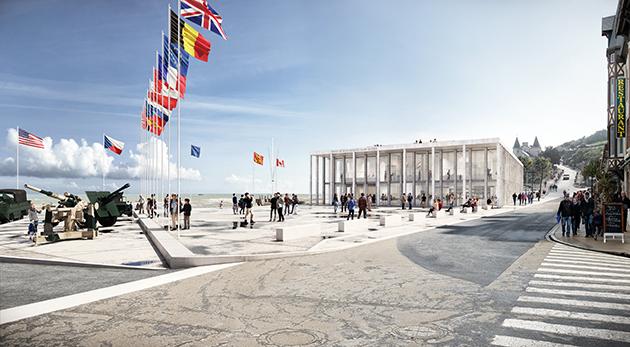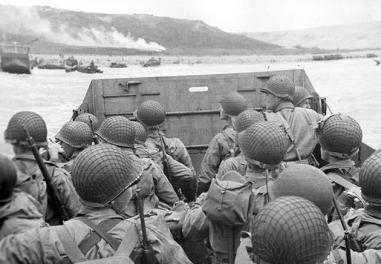Normandy museums under renovation
To combine a high-quality visitor experience with preserving their collections, the Musée du Débarquement in Arromanches and the Airborne Museum in Sainte-Mère-Église are having a facelift. The directors of the two museums discuss the renovation projects that are underway.

In 1945, the local councils of the communes where the D-Day landings took place teamed up to coordinate the postwar reconstruction effort. Proposals were put forward for anniversary events and ceremonies to be organised, and plans for building work and the construction of “key monuments” were presented to the prefect of Normandy. In this context, two organisations, in Arromanches (Calvados) and Sainte-Mère-Église (Manche), decided to build memorial museums.
Faced with the same problems – inadequate capacity of the buildings to accommodate visitor numbers (the two museums have received 30 million visitors since they opened), changing rules governing museum conservation, and the need to improve the layout and presentation of the collections – the Musée du Débarquement in Arromanches and the Airborne Museum in Sainte-Mère-Église embarked on a major renovation programme.
Arromanches, a “site museum”
The museum in Arromanches enjoys an exceptional setting at the heart of the circuit of landing beaches and overlooking the remains of what was an extraordinary technological challenge.
The failure of the Anglo-Canadian raid on Dieppe, in 1942, led the Allies to believe that no port could be taken from the enemy – and ports were crucial for getting supplies to the landing troops. Winston Churchill then had the idea of building prefabricated harbours in Britain, towing them across the English Channel and installing them in Normandy. Thus Operation Mulberry was born. One harbour was installed in the US landing sector at Saint-Laurent-sur-Mer (Mulberry A) and a second at Arromanches (Mulberry B). The purpose of the Arromanches museum is to tell the story of Mulberry B. Officially opened in 1954, the building will close its doors for the last time on 2 November 2022, to make way for a new structure.
Then a race against time will begin, for the collections to be transferred and put on display in their new setting in time to welcome visitors in March 2023. The building to receive the collections is, like Mulberry B, made entirely of prefabricated concrete, assembled on site. Its three storeys will be entirely glazed and topped with a roof terrace.
With the new building comes a new museographic approach. Set over twice the surface area, the collection will be displayed more in keeping with present-day standards. A balance will be struck between traditional display techniques and multimedia. The museum’s core purpose, to explain the history of artificial harbours, will be reaffirmed and repositioned in the context of the D-Day landings. Comprised of eight rooms, the museum visit ends with a monumental virtual reality projection superimposed on the remains of Mulberry B, followed by access to the roof terrace overlooking those same remains.
In 2023, a second building will be constructed on the site of the current museum. It will house the administrative offices and the reserves, which will comply with conservation standards regarding temperature, humidity, lighting, etc. Meanwhile, two outside spaces will be created: to the east, a pine garden where visitors can stroll and view temporary outdoor exhibitions and, to the west, a remembrance esplanade serving the museum entrance. The renewal will cost ten million euros.

External view of the Airborne Museum © Airborne Museum/PY Lemeur
The Airborne Museum, an ever-changing museum
The Airborne Museum opened its doors on 6 June 1964, with one single-storey building in the shape of a parachute (410 m²). Its centrepiece was a 1943 Waco glider. Then a second single-storey building was added in 1983 (700 m²), which housed among other pieces an American Douglas C-47 aircraft. In 2014, the museum was enlarged with a building of 1 200 m² presenting Operation Neptune, in an immersive display using sound and light that brings visitors right up close to the collections. Finally, in 2016, a conference centre was opened, comprising a 120-seat cinema and a temporary exhibition space (100 m²).
Following the extension phase, the museum wanted to renovate its two oldest buildings and also to review its museography. The very history of the remembrance site made it necessary to question both its own identity and the message and chronology being presented.
The Airborne Museum has a clearly marked identity:
- an outdoor museum, with themed pavilions;
- a museum of “histories”, whose purpose is to include the points of view of actual people in the historical narrative;
- a proactive remembrance policy aimed at moving away from “collectionitis” towards a more rational museum display.
In a museum, the objects are important, but they need to be accompanied by appropriate explanations. The museum has stepped up its mediation, increasing the number of content labels which, until now, were limited to text panels and groups of old photographs. To complement this reorganisation of content and collections, the display layout has been renewed and modernised. It now incorporates multimedia devices and puts the image centre stage. In general, the aim is to contextualise the objects in the collection and make them dynamic through displays that are less stationary. A contribution is also made by first-hand accounts and still and moving images, which play on the senses, in particular through manipulation. Finally, advantage is taken of new technologies to recreate the atmosphere and transmit the excitement, so as to maintain visitors’ interest throughout their visit.
With this in mind, the C-47 building was renovated and reopened in October 2021. Meanwhile, the project for the Waco building has evolved. The original building has been preserved to house a permanent exhibition on the theme “Saint-Mère-Église under the Occupation”, while a new building (1 000 m²) will house the glider. This final phase is due to open on 6 June 2024. The cost of these renovations is 8.7 million euros.
From remembrance to history
With visitor numbers continually on the rise, it is only right that the two museums should be involved in the 80th anniversary of the D-Day landings and the Battle of Normandy in two years’ time. Indeed, with the prospect of the last remaining eyewitnesses of these events dying out, these museums, whose message was rooted essentially in commemorating the Allied victory, are undergoing a profound change, shifting their focus from remembrance to history. With financial support from the Ministry of the Armed Forces Directorate for Remembrance, Culture and Archives, they are becoming the perfect sites for passing on that history to the younger generation.
Read more
Articles of the review
-
The file

Remembrance tourism in Normandy
Every year, remembrance tourism attracts millions of visitors to Normandy to walk in the footsteps of the liberators of 1944, bringing with it economic, cultural and civic benefits. The Normandy Region is a leading actor of the tourism sector, and works to create synergies around shared projects and...Read more -
The figure

The Juno Beach Centre
Founded in 2003 by veterans and their families, the Juno Beach Centre (JBC) is the only Canadian museum on the Normandy coast. While its purpose remains that of passing on the history and memory of the liberators of 1944, today it is committed to doing so sustainably. ...Read more -
The interview
Remembering the Dieppe Raid
The town of Dieppe, in Seine-Maritime, is preparing to commemorate the 80th anniversary of the raid that bears its name. Stéphane Canu, the town council’s head of communications, and Martine Pietrois, chair of the Jubilee Association, look back at this chapter of Franco-Canadian history and discuss ...Read more

